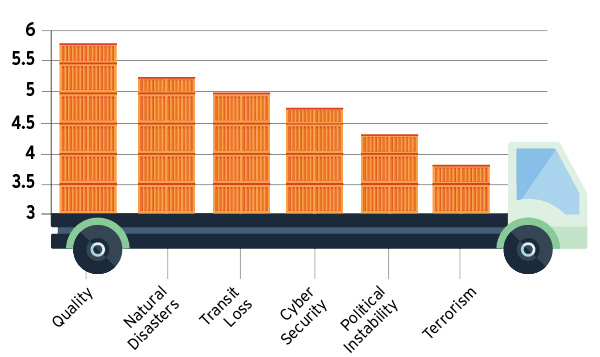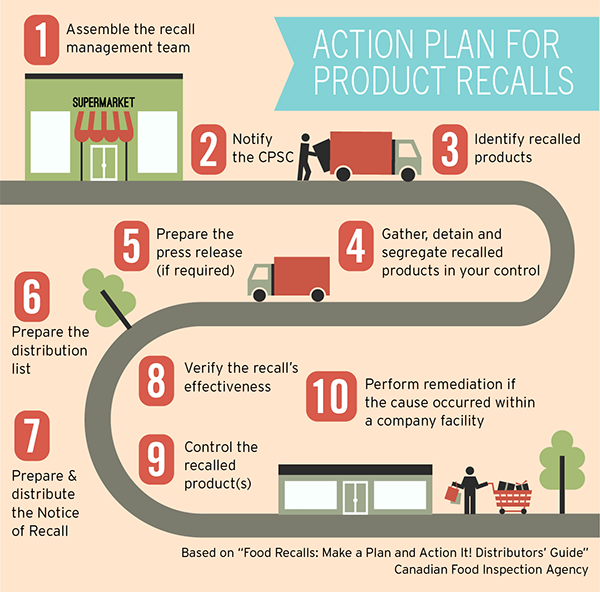Prepare for Impact

The best time to brace yourself for a supply chain disruption is before disaster strikes.
All supply chains carry an element of risk, whether it is product liability or a natural disaster with the potential to impact all channels of business, including the consumer. While most supply chain managers know to “expect the unexpected,” risk variables across industry are changing. For example, shipper expectations are evolving as sophisticated technological advances provide tools to streamline and forecast shipments in emerging markets.
Working with a third-party logistics (3PL) provider may provide insight into strategies that improve business reliability both abroad and domestically, all while meeting shipper expectations. While it is impossible to avoid every potential risk, supply chain managers representing retailers, 3PLs, and legal counsel agree that working in unison, with full transparency, typically achieves the best risk management outcomes.
The Real Risk: No Set Strategy
A 2013 Deloitte Consulting Survey reveals some top concerns among key executives, who admit that supply chain risk management is not always effective. In fact, while two-thirds of the companies that participated in the study, which included feedback from 600 executives in manufacturing, retail, and high-tech industries, have a supply chain risk management program in place, just half of the respondents believe that those programs are “effective” or “extremely effective.” Perhaps most indicative of a challenge across the supply chain as a whole, the survey finds that organizations are “often unsure” of where to focus risk management efforts.
3PL relationships serve to alleviate barriers to business, such as stringent regulations and compliance procedures, but not without sharply defined expectations. Clear communication that echoes the vision of all supply chain partners ensures that business runs effectively, despite the threat of risk.
The uptick in severe natural disasters over the past decade, including Hurricane Sandy in the Northeast in 2012, and Hurricane Katrina in 2005, and the potential for more catastrophic acts of nature, including deadly occurrences overseas, is a sweeping concern in the supply chain. In a 2014 report, Managing Risk in the Global Supply Chain, supply chain professionals list natural disasters among their top-ranked risks. The study, conducted by the University of Tennessee’s supply chain management faculty, surveyed more than 150 supply chain professionals representing manufacturers, retailers, and service providers.
For shippers, planning for the unexpected is imperative, but the right ingredients are also necessary. “When it comes to risk management, it’s important to have a program template,” says Ann Christopher, vice president and corporate counsel for Kenco, the largest woman-owned third-party logistics company in the United States.
“Nothing can prepare you completely if a disaster strikes your warehouse, but if a hurricane hits, or you suffer a significant power outage for an extended time, the more organized you are, and the more that you’ve prepared upfront, the better off you will be,” she says. Christopher recommends that shippers be proactive by asking service providers for copies of their disaster and contingency planning documentation.
“We see more interest and more sophistication on the part of shippers, who ask, ‘How will you manage my product to minimize any disruption to my supply chain?'” says Christopher.
Even so, not all contingency plans are sufficient. Well-informed shippers ask their 3PLs for disaster or business continuity plans with specific requirements in place. Those requirements, for example, can include a list of business contacts who will be accessible 24/7, what vendors the 3PL will engage, and what sort of contractors they will use to handle disaster recovery cleanup, says Christopher.
Another potential risk to business occurs when a 3PL’s facilities or supply chain network falls out of sync with a
shipper’s requirements. This can be especially disconcerting during a crisis, when lost shipments can be the most costly and when a diversion plan becomes extremely significant.
“Shippers should be prepared to divert freight to alternate locations to minimize disruption during an emergency,” says Christopher. “Kenco has customers who strategically choose to put a certain percentage of products in a southeast warehouse, for example, with the balance in a midwest warehouse because the probability is 99.9 percent that the same disaster situation will not impact both those geographic regions.” Such strategies are imperative to consider when developing business continuity plans.
Security measures are another area that 3PLs and shippers need to approach with caution. “It’s important for shippers to recognize the product type they are storing, and if the 3PL needs to make certain enhancements to the storage facility and/or security program,” Christopher says. “The 3PL also needs to be up front in assessing the costs associated with proper security control mechanisms.”
Ultimately, partners need to work together to ensure that security will be sufficient based on the product type, and the expectations and requirements of the owner of the goods, while also accounting for the facility’s location.
Geographic location and shifting business to emerging markets has also led 3PLs to invest in data technology, a best practice tool that addresses key risks to business, including theft, property damage, and shipment delays. Shippers moving cargo across the border, for instance, must effectively communicate with several parties, and may lose track of freight, or worse, lose business at the border. Working with 3PL providers that have key insights into foreign operations, and knowledge of stringent regulations that ensure compliance, helps alleviate threats to business.
From a 3PL perspective, managing different requirements for different countries and related cargo security declarations has been one of the largest growing areas of concern over the past five years, according to Scott Sangster, vice president of the global logistics network for Descartes Systems Group, which provides on-demand, Software-as-a-Service logistics solutions.
Due in part to changing customer demands, Descartes invested heavily in compliance technology in recent years. “Shippers need information not only on what goods can be shipped into what countries, and the cost of importing goods into those countries, but also on meeting cargo security requirements by declaring those goods in advance,” Sangster says.
Before any goods are loaded onto an aircraft or vessel for shipment abroad, many countries request that information about those goods—right down to the line-item level—”is filed before the goods are even loaded on a vessel, aircraft, or truck,” says Sangster. “Countries want insight into what goods are being sent to them well in advance so they can stop any risk offshore before it gets within their border.
“The World Customs Organization is starting to create a published framework of security requirements that many countries around the world are adopting,” he adds. “More countries are starting to push out their borders in the delivery of goods. Sometimes the movement of data is as significant as the movement of physical goods.”
Sangster also warns that if data doesn’t get to the right parties in advance, the shipment could be held in limbo because carriers won’t handle those goods unless they know they have already been cleared to enter a country or cross a border.
“New requirements over the past several years are starting to push the collection of transportation data farther back in the supply chain—to the manufacturers and shippers of the goods who have to get their information to the 3PL before their goods start to move,” Sangster says.
The transformational shift has changed business to more of a collaborative effort among manufacturer, shipper, and end consumer. “It has changed the relationship between transportation service providers, intermediaries, shippers, and consumers because they realize they have to share information to ensure goods move properly and quickly,” Sangster says. “They also realize that interruptions in the flow of data can cause significant delivery delays.
“In the past, we didn’t have that collaboration, or the full end-to-end view that parties need today to ensure products are not offloaded and sitting in a container in a port for a few days while the data catches up,” he adds.
Rating Supply Chain Risks
Supply chain executives rate their most pressing concerns on a scale of 1-10 (10 indicating greatest concern).
SOURCE: Managing Risk in the Global Supply Chain, University of Tennessee.
The Big Data Equation
“The past few years have brought huge technological innovations,” notes Andy Souders of Savi Insight, a sensor analytics solutions company that creates operational intelligence from the Internet of Things (IoT). The most consequential shift, Souder says, occurred in 2014, the first year in which data created by sensors across the globe surpassed data generated by people.
“The decreasing cost of sensors, coupled with the rise of the IoT, has given shippers access to more data than ever before,” Souders says.
Parties across the supply chain need to understand all the data being generated, as investment in big data continues to add transparency to business. It helps alleviate security issues, such as theft and tampering of high-value assets—costly incidents that can also tarnish a company’s reputation.
Companies that provide this type of data insight also add to the much-needed transparency through the business process, enabling 3PLs to anticipate any potential supply chain disruptions and delays. Analytic applications that utilize data from sensors and public sources help identify insights that impact shippers daily.
For example, Savi provides insight based on data that can indicate, and ultimately determine, whether a shipment needs to be rerouted. Data can identify anything from a traffic jam reported on Twitter, to sun glare on a certain road at a particular time, to historical statistics that suggest a cargo theft hotspot.
Technology has also added to data accessibility, and is a way for all parties to get involved. “Technology vendors have to provide more open systems to communicate information,” says Sangster. “In the past, the technology wasn’t able to consume and share information, and everyone worked in silos. The collaborative nature of business today is driving the fact that supply chain partners have to share data about their business.
“We will continue to see more open access for shippers to interact with supply chain data, and they won’t have to be sitting at their desk to view it,” he adds. “Mobile workers are now doing the data collection, while executives manage that process remotely as well.”
What Matters Most
A 3PL can meet shipper expectations about risk management by developing a deep understanding of what the shipper needs. “Many say third-party logistics is a rate business, but it’s not; it’s a relationship business,” says Mel Redman, owner of logistics and warehousing company Redman and Associates.
“Any 3PL can provide a rate, but they have to perform,” says Redman. “They have to be there as an extension of the customer’s company.” The relationship between shipper and 3PL has to be rock solid, he contends, “because of the risk, because of the claims, because of everything that can go wrong.
“If, for example, your 3PLs do not understand the retailers they are shipping to, they also may not understand the specifications that you have to meet,” Redman cautions. “A retailer can blindly enter into a 3PL relationship, and all of a sudden, if the 3PL doesn’t deliver, it hurts their sales business.”
Redman says he spends an “inordinate amount of time” educating his third-party supplier, third-party vendors, and 3PL, on delivery requirements and agreements, and the consequences of missing a must- arrive-by day.
“There are penalties for missing all those things,” he notes. “Shippers need to get their 3PL providers to understand that, and to operate as an extension of their companies. That’s the key.
“We have a meeting minimum every quarter with those major providers,” Redman says. “We have them in for multiple days, go over their report card, and set goals for the next quarter. You’ve got to set goals and you’ve got to have criteria for performance for 3PL providers.”
Running Risk Scenarios
Performing what-if
scenarios with supply chain data and through mock scenarios can also alleviate risk along the supply chain, but only if there are a few key elements in place.
In case of an emergency such as an unexpected event, or a recall, businesses need a few strategies to keep them running, according to Todd Harris of Stericycle ExpertSOLUTIONS, which manages recalls. He recommends a plan that identifies the players who own the recall team, and how they will identify affected parties.
“Who will manage the website? Can we manage call center or inbound phone calls for those who have the recalled product? All of those nuts and bolts need to be mapped out in advance in an ironclad plan,” Harris says.
“We highly recommend that companies test their recall plan routinely, at least once or twice every year, by doing what we call mock recalls,” he says. “Mock recalls put the team through their paces unannounced to see how well the recall plan functions.”
Mock preparation throughout the supply chain is integral, especially when considering some recent findings.
“The top trend that we saw in the first quarter of 2015 was what we call the ‘multiplier effect,'” says Harris. “The multiplier effect happens when supplier issues trigger recalls with multiple brands, leading to incredibly complex recalls that are not only massive in size, but also may play out over different regions of the world and with different regulatory bodies.” Such an impact can touch every part of the supply chain.
Harris references the recent peanut-tainted cumin recall, which affected products that tested positive for the undeclared (and potentially deadly) peanut protein. The recall ultimately affected 14 different companies, 100 different brands, and 153 different products. It crossed not only products regulated by the Food and Drug Administration, but also over to the U.S. Drug Administration’s regulated products. That is a rare occurrence, and it adds another layer of complexity. That single recall affected many different companies, many different brands, many different products, and multiple regulatory agencies.
Taking the Right First Steps
While multiple scenarios can go wrong across the supply chain, identifying liabilities and responsibilities helps to avoid finger pointing. Shippers may incorrectly assume that that they are outsourcing not only the job function, but also all risk associated with their products, while they are in the care, custody, and control of the 3PL provider, says Kenco’s Christopher.
Key tactics include not only anticipating and assessing a worst-case scenario, such as a warehouse fire, for instance, but also identifying the stakeholders and their associated responsibilities, Christopher notes. She urges companies to ask some key questions, including: Who has the respective liability associated with the inventory under a certain circumstance?
“We also try to make it clear to our customers that liability is actually dictated by the law—the Uniform Commercial Code,” she says. Article 7 of the Uniform Commercial Code identifies the duty of care imposed upon the warehouse provider, and it’s a reasonable care standard, for example.
A warehouse provider is not going to be held liable for loss or damage caused by a catastrophic tornado hitting a site, Christopher explains. Other weather- related conditions, such as floods, are also beyond the warehouse’s responsibility.
“The Code also specifies that the parties may establish a limitation of damages,” she says. “So not only are you tied to that reasonable care standard, but even in the event of negligence, there is generally an understood limitation of damages that will be in effect.”
Most of all, Christopher says, it’s essential for all parties to have a mutual meeting of the minds to understand their respective liabilities and obligations. “Those conversations are important to have up front rather than after the fact,” she advises.
Whatever risks your company may face, working closely with your third-party providers, and having strategies in place before disaster strikes, will keep your supply chain moving.


